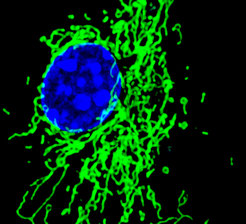New links between the mitochondria and the nucleus
Researchers from Freiburg find new links between macrophage metabolism and function
Macrophages are known for engulfing and digesting pathogens, cellular debris, and cancer cells. Thus, they are an essential component for our immune system in fighting against infections as well as cancer. Recent studies have shown that metabolic changes of macrophages can shape their activation state and function. A joint research group in the MPI of Immunobiology and Epigenetics and the University of Freiburg was now able to directly link changes in macrophage metabolism in response to changing environmental stimuli to gene expression in the nucleus and therefore activity of macrophages. Their results may provide interesting strategies for therapeutic intervention for cancer and inflammatory diseases.
Macrophages belong to the first line of defense against infections and wounds. As front-line cells of the innate immune system, they sense and immediately respond to invading pathogens by Pacman-like ingestion of microbial intruders and by alerting other immune cells to help. Macrophages also take part in maintaining normal tissue functions and play numerous roles in cancerous diseases. Understanding the way in which macrophages function in these various roles could enable scientists to therapeutically manipulate their behavior during disease.
Immune cell metabolism drives immune cell function
Research in the laboratory of Edward Pearce at the Max Planck Institute of Immunobiology and Epigenetics (MPI-IE) and the University of Freiburg is dedicated to the fast-evolving field of immunometabolism dissecting the contribution of the metabolic machinery of immune cells to their development and function. In recent years, it became apparent that immune cells, such as macrophages, in the specific microenvironment of inflamed tissue or tumors change their metabolic program to fulfill cellular needs, such as growth and proliferation, or to carry out specific functions, such as phagocytosis and cytokine production.
In this context, research by the Pearce laboratory and others showed that macrophages dramatically change nutrient uptake and use when they become activated in response to environmental stimuli that arise as a result of infection or tissue damage. Interfering with the metabolic profile of macrophages can prevent, boost, or completely alter the activation of these cells. However, the way in which metabolism and activation are linked is not fully understood.
Linking mitochondria metabolism to gene expression in the nucleus
In their newest study, published in Immunity, the Freiburg researchers discovered that one way in which macrophage activation is linked to metabolism is via a protein called ETV1. The protein communicates changes on mitochondrial biology to gene expression in the cell's nucleus.

Mitochondria are responsible for the generation of energy through respiration. By establishing an electrochemical gradient between the membranes of a mitochondrion, called membrane potential, a cell drives the production of ATP, which is the common currency of biological energy. “This is akin to the energy stored in a dam. The controlled release of this electrochemical gradient is harnessed to fuel the energetic needs of the cell, just like the gradual passage of water through turbines is used to generate electricity,” explains David E. Sanin, first author of the publication.
Interestingly, the team around Edward Pearce realized that signals encountered by macrophages during inflammatory processes could cause them to lose mitochondrial membrane potential. This process, in turn, is able to affect the function of ETV1, allowing it to regulate the expression of critical genes that control macrophage function, including a gene that encodes a protein that is involved in wound healing.
“Our findings serve to illuminate a mechanism that directly links changes in macrophage metabolism in response to changing environmental stimuli to changes in macrophage function,” says Edward Pearce. The results reveal that the protein ETV1, sensitive to membrane potential changes of the mitochondrial metabolism, mediates gene expression in the nucleus and therefore activity of macrophages. Moreover, the protein ETV1 represents a potentially new therapeutic target that could be used to manipulate the behavior of our immune cells. The scientists hope that these results will be able to broaden the therapeutic options for targeting macrophage activation during disease.











